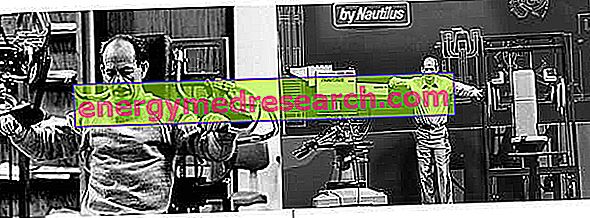Since I receive many messages requesting information on hybrid training protocols and it is not possible to answer everyone, I will try to give an exhaustive, albeit brief, answer in this article.
The hybrid training program is a combination of training methods (between Heavy Duty - or HIT - with other methodologies) aimed at obtaining a high intensity in a restricted volume of work, with the aim of maximizing the damage to the myofibrillar structure, therefore to obtain an increase in the transverse diameter of the fibers (increase in muscle mass).

The HIT training system - designed by Arthur Jones (great theorist and scholar of training methodologies, inventor of the first Nautilus cam machines) in the late 1960s and subsequently developed and customized by Mike Mentzer (hence the name Heavy Duty ) - is based on the achievement of concentric muscle failure, through a low frequency and a low volume of work.

Therefore, this combination of methodologies - while basing its main base on Heavy Duty - exploits the different methodologies, such as the training zone or the POF for example, in order to obtain what I call "synergy of muscle stress", whose purpose it is easy to understand.
However, I remember that in order to achieve muscle and performance gains, it is of fundamental importance to respect the physiological equilibrium of the organism, as well as to manage muscular and systemic stress, through a schedule of the frequency and any periods of discharge. To give you an exhaustive idea, I refer you to the "General Adaptation Syndrome (GAS), or stress theory, by Hans Selye".
Not least the structuring of the program will have to take into account the age of training of the subject, age, his morphology and biomechanics, but also his character profile (it will seem strange to someone, but also this aspect is of fundamental importance).

Example of Hybrid Protocol - POF HD
Training A)
DIST. P. ORIZZ. BALANCE (PI) 1X8-1X6
CROCI P. ORIZZ. MAN. (PE) 1X 1012
CROSSES WITH CABLES (PC) 1X810 + 1X68 TO SCALAR
CHEST PRESS HD 1X810 + 1X68 A SCALAR
PULL IN THE BIT. (PE) 1X1012
DELTS MACHINE (PC) 1X810 + 1X68 A SCALAR
SHOULDER PRESS HD 1X810 + 1X68 SCALAR
TRIC. AL TRICEPS HD 1X810 + 1X68 TO SCALAR
Training B)
PRESS 45 ° (PI) 1X15 -1X10
HACK SQUAT (PE) 1X 1012
LEG EXTENSION (PC) 1X1012 + 1X68 A SCALAR
HORIZED PRESS HD 1X1215 + 1X810 A SCALAR
LEG CURL STANDING (PE) 1X1012
DISTANCE LEG CURL (PC) 1X810 + 1X68 A SCALAR
CALF MACHINE HD 1X1520
CRUNCHES 1XMAX
Training C)
IPEREXTENSION 1X1520
TRAZ. LAT M. AVANTI (PI) 1X8-1X6
ABB. FRONT PANELS WITH LAT M. (PE) 1X 1012
PULLEY REVERSE SOCKET (PC) 1X810 + 1X68 TO SCALAR
MAN REMATER ALT. HD 1X810 + 1X68 A SCALAR
CURL BILANC. HD 1X810 + 1X68 A SCALAR
LEG RAISE P. ORIZZ. 1XMAX
NOTE. In the POF (Positions of Flexion) method, the articulated ROM of each exercise must be divided into 3 parts:
- Intermediate position (PI) or the medial part of the movement.
- Eccentric position (PE) or the lengthening part.
- Contraction position (PC) or the concentric part of the exercise.
To give an example: In the bench press exercise with balance the intermediate position (PI) is exactly that of the middle, in which the barbell never touches the chest (stopping at about a palm) nor does it lead to total extension of the arms during the pushing phase (an extension of the arms of approximately 100110 ° is achieved).
In the exercise of crosses on horizontal bench with handlebars, the eccentric position (PE) is that with the arms in horizontal position (in stretching of the breastplate, prerequisite for the stimulation of the myotactic reflex), the range of movement will consist in the adduction of arms up to a third of the total movement.
The execution time in all three phases is approximately 1 + 1 (1 second + 1 second).
In the HD series the ROM will be complete, with an execution time of 6 + 4 (6 seconds in the positive phase of the movement, 4 seconds in the negative phase).
The recoveries between the setesercizi will start from a minimum of two minutes, up to a maximum of 3.



